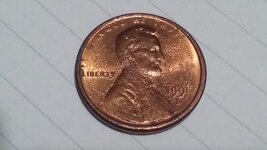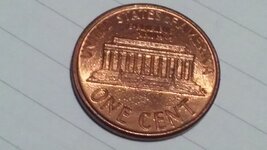Navigation
Install the app
How to install the app on iOS
Follow along with the video below to see how to install our site as a web app on your home screen.
Note: This feature may not be available in some browsers.
More options
You are using an out of date browser. It may not display this or other websites correctly.
You should upgrade or use an alternative browser.
You should upgrade or use an alternative browser.
is this a greaser or pmd?
- Thread starter griffith 90
- Start date
dejapooh
Bronze Member
I'm guessing it is an incomplete laminate of the copper onto the zinc. I guess you could get the same result from heat as PMD, but the color would likely be effected too...
enamel7
Gold Member
- Apr 16, 2005
- 6,383
- 2,545
- Detector(s) used
- Garrett AT Gold
- Primary Interest:
- All Treasure Hunting
Looks like heat damage to me!
port ewen ace
Silver Member
- Dec 16, 2012
- 4,065
- 7,787
- 🏆 Honorable Mentions:
- 2
- Detector(s) used
- AT-PRO & Equinox800
- Primary Interest:
- All Treasure Hunting
found a few Zincolns from '83 & newer with the "Colonel Kurtz" look, my guess is massive gas bubbling of the clad layer on both surfaces. bet the bumps collapse when ya' push on 'em
huntsman53
Gold Member
IMHO, poorly prepared Zinc planchet which did not allow for good adhesion of the Copper plating thus creating air or gas bubbles underneath. Excessive heat transferred from the Dies to the planchet during the minting process, may have aided the separation.
Frank
Frank
griffith 90
Jr. Member
- Thread starter
- #6
they're solidfound a few Zincolns from '83 & newer with the "Colonel Kurtz" look, my guess is massive gas bubbling of the clad layer on both surfaces. bet the bumps collapse when ya' push on 'em
griffith 90
Jr. Member
- Thread starter
- #7
IMHO, poorly prepared Zinc planchet which did not allow for good adhesion of the Copper plating thus creating air or gas bubbles underneath. Excessive heat transferred from the Dies to the planchet during the minting process, may have aided the separation.
Frank
would it be worth keeping?
huntsman53
Gold Member
would it be worth keeping?
It is up to you! They are definitely odd and somewhat conversation pieces in trying to envision scenarios and conditions that could have caused the effect and some folks do collect them.
Frank
griffith 90
Jr. Member
- Thread starter
- #9
It is up to you! They are definitely odd and somewhat conversation pieces in trying to envision scenarios and conditions that could have caused the effect and some folks do collect them.
Frank
thank you
SorenCoins
Full Member
- Apr 5, 2015
- 213
- 91
- Detector(s) used
- Minelab Go Find 60, Bounty Hunter Sharp Shooter II
- Primary Interest:
- All Treasure Hunting
This is when during the minting process they were casting the hot zinc which released fumes, of zinc oxide. This got trapped under the copper plating. So yes, technically it is a mint error. I keep only major examples of this as it doesnt have to much additional value
enamel7
Gold Member
- Apr 16, 2005
- 6,383
- 2,545
- Detector(s) used
- Garrett AT Gold
- Primary Interest:
- All Treasure Hunting
This is when during the minting process they were casting the hot zinc which released fumes, of zinc oxide. This got trapped under the copper plating. So yes, technically it is a mint error. I keep only major examples of this as it doesnt have to much additional value
Casting the hot zinc? What are you talking about?
huntsman53
Gold Member
SorenCoins
Full Member
- Apr 5, 2015
- 213
- 91
- Detector(s) used
- Minelab Go Find 60, Bounty Hunter Sharp Shooter II
- Primary Interest:
- All Treasure Hunting
I meant when they are heating the planchet for an easy strike
enamel7
Gold Member
- Apr 16, 2005
- 6,383
- 2,545
- Detector(s) used
- Garrett AT Gold
- Primary Interest:
- All Treasure Hunting
They don't heat the planchets before striking.
dejapooh
Bronze Member
I meant when they are heating the planchet for an easy strike
They heat the blanks before striking. I once took a tour of the mint as part of an ANA program. There was no heating of the blanks (this was back in about 1980). The heat necessary to make any appreciable change in striking would be extreme (red hot to white hot), and the damage to the finish would require polishing after striking. I can see that being useful in High Relief issues, but for something this low, very doubtful.
Users who are viewing this thread
Total: 2 (members: 0, guests: 2)





